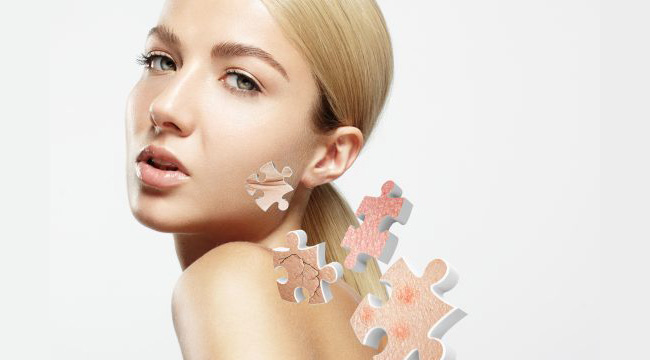Aging of the skin is the result of more than just years on the calendar. Exposure to environmental factors like sunlight, pollution, smog, and cigarette smoke and air pollution causes photo-aging. You may already be aware that sun damage is a leading cause to aging but another culprit is free radicals.
What are free radicals?
Free radicals are atoms that contain an odd number of electrons. Like Bachelorette contestants, atoms like to be paired so they will seek out and scavenge the body to seek out the electron it’s missing, attacking and destroying other necessarily healthy atoms in the process. These free radicals can become highly unpredictable since they are unstable and can easily cause our cells to change quickly. This cascade of events can lead to oxidative stress.
What is oxidative stress?
Oxidation happens as a result of our cells coming into contact with oxygen, so the simple act of breathing can cause oxidation. While oxidation is a normal process, oxidative stress occurs when our bodies cannot keep up with protecting us against these free radicals. Normally, the body can handle free radicals, but if free-radical production becomes excessive, damage can occur. Over time, it can result in degraded collagen, the protein in fibers that serve as the building blocks of our skin. Think of it as scaffolding, it provides strength and structure to skin. Youthful skin has strong abundant collagen which looks firm. As we age or are exposed to sun and free radical damage, collagen breaks down and loses elasticity and bounce. Free radicals can also create changes in skin color (brown spots and broken blood vessels) and weakened skin that looks loose and saggy because of damaged elastic fibers. In fact, free radicals have even been associated with skin cancer and premature skin-aging due to sun exposure (which speeds up this free radical damage) and other diseases.
Having a hard time imagining oxidative damage? Imagine a cut avocado, when it’s freshly sliced, the flesh may look taut and spotless. Over a few hours though, it’ll quickly turn brown and wrinkly. That’s the process of oxidation. If you pour a little lemon juice (Vitamin C) over the top, it can help your guac from browning. Similarly, the right antioxidants can help our complexions stay spotless.

How can you treat oxidation?
Some studies show that while sunscreens are an essential first line of defense, they block only 55% of damaging free radicals that cause chemical reactions in the skin. Studies show that antioxidants effectively neutralize chemical reactions generated when skin is exposed to environmental assaults. Antioxidants are compounds that can donate an electron to a free radical so that the free radical doesn’t have to take the electron from the skin’s atoms. They can help calm down and neutralize free radicals, keeping them from being harmful to others. While our body produces antioxidants, we can also get them from eating foods with certain vitamins and minerals. For our skin, free radical damage can be controlled and prevented by applying skin care products with antioxidants directly onto the skin. Topical products containing antioxidants in effect, defend the skin, help in reducing scars and promote healing. Since the antioxidants are destroyed or oxidized in the process, you must continue to feed the body and skin with fresh antioxidants to keep up with the free-radical damage. Consider it a two fold approach, always layer an antioxidant rich serum or moisturizer along with a broad-spectrum SPF of 30+ every day to create a strong defense.
Here, some of our favorite antioxidants:
 Vitamin C (Ascorbic acid) – It is an antioxidant vitamin necessary for tissue growth and repair, as well as collagen formation. It helps combats free radicals triggered by both body and environment. Also, it works synergistically with Vitamin E so looking for a serum or treatment that contains both creates a supercharged effect.
Vitamin C (Ascorbic acid) – It is an antioxidant vitamin necessary for tissue growth and repair, as well as collagen formation. It helps combats free radicals triggered by both body and environment. Also, it works synergistically with Vitamin E so looking for a serum or treatment that contains both creates a supercharged effect.
Vitamin E (Tocopherol)- This is the first recognized fat-soluble antioxidant usable in skin care products. One of the most potent antioxidants, it’s particularly good defending against and disabling free radicals made by the body. Essential to tissue repair, works synergistically with vitamin C.
Ginko Biloba– Derived from the Ginko biloba trees, its a very potent antioxidant that improves blood flow (including microcirculation in small capillaries) to most tissue and organs.
Green tree extract– A natural antioxidant part of the tannin family, it’s rich in chemicals known as polyphenols. It is a very potent antioxidant shown to neutralize free radicals generated form inflammatory conditions.
Pomegranate extract– A powerful antioxidant that contains lycopenes which have natural UV blocking elements.
Ginseng– A slow growing perennial plant, it assists in increasing the body’s resistance to stress.
Soybean oil– An emollient plant oil with antioxidant properties, high concentrations of vitamin E help protect skin cell membrane.
Royal jelly– It contains Vitamin A, B, C, D, E, K, minerals and amino acids and other important constituents including collagen. It is complete nutrition for the skin and is used to prevent wrinkles and treat acne.
Yeast extract– A source of beta glucan, it’s considered a potent antioxidant that helps support the immune system.
Rosehip seed oil– rumored to have been used by Kate Middleton during her pregnancies, this fruit of rose is a berry-like structure called rose hip. Rose hip seed oil is a good emollient and contains Vitamin A D E, antioxidant flavanoids, and is among the richest source of Vitamin C of any plant. Pure Rosehip contains around 75% fatty acids, which help maintain healthy skin and reduce the appearance of pores.
